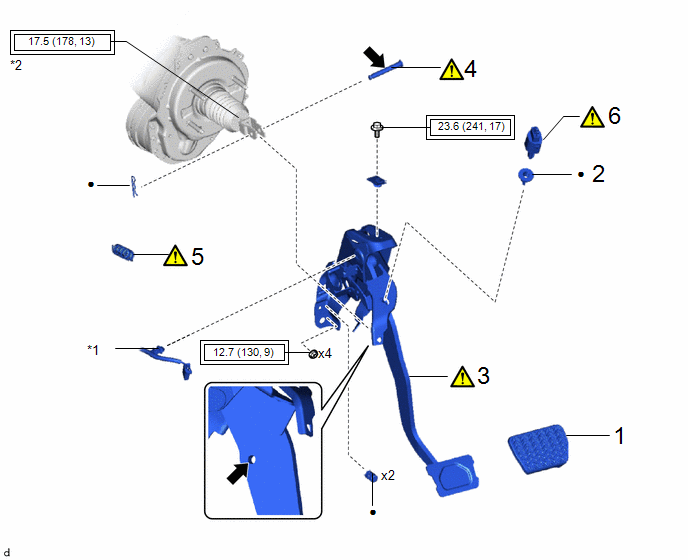Toyota Corolla Cross: Installation
INSTALLATION
CAUTION / NOTICE / HINT
COMPONENTS (INSTALLATION)
|
Procedure |
Part Name Code |
.png) |
.png) |
.png) |
|
|---|---|---|---|---|---|
|
1 |
BRAKE PEDAL PAD |
47121 |
- |
- |
- |
|
2 |
STOP LIGHT SWITCH MOUNTING ADJUSTER |
84345 |
- |
- |
- |
|
3 |
BRAKE PEDAL SUPPORT ASSEMBLY |
47110 |
|
- |
- |
|
4 |
PUSH ROD PIN |
47264A |
|
- |
- |
|
5 |
BRAKE PEDAL RETURN SPRING |
47101A |
|
- |
- |
|
6 |
STOP LIGHT SWITCH ASSEMBLY |
84340 |
|
- |
- |
|
*1 |
WIRE HARNESS |
*2 |
LOCK NUT |
.png) |
Tightening torque for "Major areas involving basic vehicle performance such as moving/turning/stopping": N*m (kgf*cm, ft.*lbf) |
● |
Non-reusable part |
.png) |
Lithium soap base glycol grease |
- |
- |

|
Procedure |
Part Name Code |
.png) |
.png) |
.png) |
|
|---|---|---|---|---|---|
|
7 |
BRAKE PEDAL STROKE SENSOR ASSEMBLY |
89510D |
|
- |
- |
|
8 |
INSPECT AND ADJUST BRAKE PEDAL |
- |
|
- |
- |
|
9 |
NO. 1 AIR DUCT |
87211 |
|
- |
- |
|
10 |
FRONT NO. 1 CONSOLE BOX INSERT |
58816D |
- |
- |
- |
|
11 |
INSTRUMENT PANEL SAFETY PAD ASSEMBLY |
55400 |
- |
- |
- |
|
12 |
PERFORM INITIALIZATION AND CALIBRATION |
- |
- |
- |
|
|
13 |
CHECK AND CLEAR DTC |
- |
|
- |
- |
.png) |
N*m (kgf*cm, ft.*lbf): Specified torque |
● |
Non-reusable part |
PROCEDURE
1. INSTALL BRAKE PEDAL PAD
2. INSTALL STOP LIGHT SWITCH MOUNTING ADJUSTER
3. INSTALL BRAKE PEDAL SUPPORT ASSEMBLY

(1) Install the nut to the brake pedal support assembly.
(2) Temporarily install the brake pedal support assembly with 2 new clips.
(3) Install the 4 nuts.
Torque:
12.7 N·m {130 kgf·cm, 9 ft·lbf}
NOTICE:
Tighten the nuts in the order shown in the illustration.
(4) Install the brake pedal support assembly to the instrument panel reinforcement assembly with the bolt.
Torque:
23.6 N·m {241 kgf·cm, 17 ft·lbf}
(5) Engage the clamp to install the wire harness to the brake pedal support assembly.
4. INSTALL PUSH ROD PIN

.png) |
Lithium soap base glycol grease |
- |
- |
(1) Apply lithium soap base glycol grease to the push rod pin and installation hole of the brake pedal support assembly.
(2) Connect the brake master cylinder push rod clevis to the brake pedal support assembly with the push rod pin, and install a new clip as shown in the illustration.
NOTICE:
Be sure to install the push rod pin in the correct direction.
5. INSTALL BRAKE PEDAL RETURN SPRING

(1) Install the brake pedal return spring to the brake pedal support assembly and push rod pin as shown in the illustration.
6. INSTALL STOP LIGHT SWITCH ASSEMBLY
.png) |
Click here |
7. INSTALL BRAKE PEDAL STROKE SENSOR ASSEMBLY
.png) |
Click here |
8. INSPECT AND ADJUST BRAKE PEDAL
Click here .gif)
9. INSTALL NO. 1 AIR DUCT
.png) |
Click here |
10. INSTALL FRONT NO. 1 CONSOLE BOX INSERT
Click here .gif)
11. INSTALL INSTRUMENT PANEL SAFETY PAD ASSEMBLY
Click here .gif)
12. PERFORM INITIALIZATION AND CALIBRATION
- After Parts Removed/Installed/Replaced:
Click here
.gif)
- After Reconnecting Auxiliary Battery Terminal:
HINT:
When disconnecting and reconnecting the auxiliary battery, there is an automatic learning function that completes learning when the respective system is used.
Click here
.gif)
13. CHECK AND CLEAR DTC
Click here .gif)


